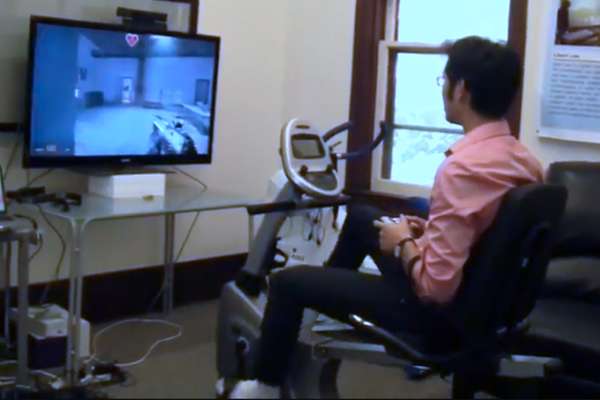Pedalling into video game future

Nicholas Graham (Computing) and his team of researchers in the EQUIS Laboratory have developed a new way to get video game players moving - by turning pedal power from a stationary bike into in-game powerups for players.
"There are a lot of people who are intimidated by exercise, who don't think they would enjoy exercise, who don't know where to begin with exercise or have trouble fitting it into their day, but who are passionate about games," says Dr. Graham. "Being able to take the enjoyment of games and map them over to include a physical activity component could be a gateway to doing exercise for many people."
In their latest paper, titled Thighrim and Calf-Life: A Study of the Conversion of Off-the-Shelf Video Games into Exergames, Dr. Graham and students Mallory Ketcheson (MSc'16) and Luke Walker (Cmp'15) explore the process and benefits of converting mainstream commercial game titles into video games with an exercise component.
The team compared two approaches for converting off-the shelf games: black-box conversion (where pedalling on a stationary bike is mapped to movement of the player's avatar in the game), and deeper integration of exercise into the game through modding (using a programming interface provided by the game manufacturer).
In each method, users controlled their game avatars using a standard game controller in addition to a stationary bicycle. In various tests, players either controlled their avatar's movement by cycling, or were able to score power-ups – such as stronger weapons or faster healing – by cycling at a more rapid pace.
The paper also discusses how pacing of various games can affect their utility as exergames. Many popular titles consist of numerous stops-and-starts during play, which makes elevating and maintaining the player's heart rate challenging. The researchers found greater success in using heart rate and pedalling input as the key to an in-game power-up, encouraging the player to keep active.
The results showed that the simple black-box conversions led to low levels of exercise, while the deeper conversions using mods and power-ups brought player heart rates close to recommended levels for moderately vigorous cardiovascular exercise. As a result, Dr. Graham and his colleagues determined the approach shows promise as an anti-sedentary activity. Of note, the researchers also found that games with less precise control requirements were better suited for conversion, as pedalling often made fine control more challenging.
More information: qspace.library.queensu.ca/bits … ory_D_201601_MSc.pdf




















